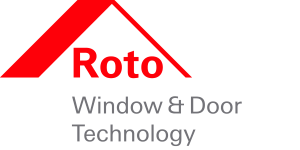Q + A with Roto Frank North America | Innovative Solutions Shaping the Future
How energy efficiency, smart technology and evolving design demands are transforming North America’s window and door industry
Above: Roto North America showcased a new line of black hardware, weatherseals and casement line at GlassBuild 2024 in Dallas, Texas.
 Homeowners’ increasing demands for energy efficiency, modern aesthetics and smart home integration are driving transformative shifts in the residential window and door market. Manufacturers like Roto North America are responding to the rising popularity of larger, brighter openings with expansive windows and doors, contemporary color schemes emphasizing sleek finishes like black, and sophisticated home automation features that enhance security and accessibility by innovating hardware that balances durability, performance and affordability—incorporating advanced sealing technologies, multi-point locking systems and automated functions.
Homeowners’ increasing demands for energy efficiency, modern aesthetics and smart home integration are driving transformative shifts in the residential window and door market. Manufacturers like Roto North America are responding to the rising popularity of larger, brighter openings with expansive windows and doors, contemporary color schemes emphasizing sleek finishes like black, and sophisticated home automation features that enhance security and accessibility by innovating hardware that balances durability, performance and affordability—incorporating advanced sealing technologies, multi-point locking systems and automated functions.
Window + Door sat down with Dan Gray, director of sales, Roto Frank North America, to discuss how they are meeting these trends head-on and how a strong North American manufacturing presence, strategic use of digital tools and commitment to sustainability through AI-driven processes have positioned the company to lead through industry consolidation and evolving market needs.
Monitoring Macrotrends
Window + Door: What are the most significant residential market trends you are seeing right now?
Dan Gray: Energy efficiency continues to be a significant residential trend in the market, as homeowners prioritize sustainability and cost savings. Broader sight lines are also in demand, with open layouts and expansive windows creating brighter, more spacious living environments. Contemporary color schemes, especially black, are also gaining traction for their sleek, modern appeal. Additionally, integrated home automation is a highly sought-after feature, offering enhanced accessibility and security.
WD: How are these trends shaping expectations for windows and doors?
DG: The growing emphasis on trends such as energy efficiency is driving demand for windows and doors with enhanced sealing, insulation and locking mechanisms that contribute to overall thermal performance. As preferences shift toward larger windows and doors, there’s also an increasing need for robust hardware solutions that can support the added weight and dimensions without compromising functionality or aesthetics. The rise of smart home integration has also elevated expectations for connected features, such as automated locking systems, sensors and remote operation capabilities.
WD: Are you seeing notable differences in market trends or customer demands between different regions in North America?
DG: There are some notable differences in marketing trends across the region, such as the southern regions. In the Southeast, there’s a strong emphasis on impact-rated products, while the Southwest is seeing a growing interest in pivot doors, reflecting a preference for bold architectural statements and modern design. While energy efficiency is a nationwide priority, it’s especially critical in northern states, where insulation and thermal performance play a larger role.
WD: What are the biggest challenges that window and door manufacturers are facing in meeting these residential market demands?
RF: One of the most significant challenges is maintaining a strong value proposition while adapting to evolving market expectations. As demand grows for features like energy efficiency, larger formats, and smart technology integration, manufacturers must balance innovation with affordability. Delivering high-performance products without pricing out key market segments requires careful engineering, strategic sourcing, and ongoing cost management.
Responding to Innovation
WD: How does Roto use market feedback and data to inform the development of new hardware solutions?
DG: Our sales team actively monitors evolving customer needs and industry shifts, then collaborates with our research and development department to translate those insights into targeted product innovations. A recent example is the DuoTilt sash lock for hung windows, which combines the lock and latch into a single, compact mechanism. This design responds to growing demand for streamlined aesthetics and enhanced durability, delivering a solution that aligns with both functional and visual expectations in the market.
WD: With a growing focus on sustainability, how do Roto’s hardware solutions contribute to the energy efficiency of a window or door system?
DG: Roto’s hardware solutions contribute to the energy efficiency of window and door systems by optimizing sealing performance and material selection. Through continuous testing and engineering refinement, we ensure our components deliver airtight closure without compromising ease of operation. We also incorporate recycled materials that are rigorously strength and durability tested to match the performance of raw materials. One example is the use of ball bearings in locking cams, which reduce friction and improve mechanical efficiency, helping maintain consistent sealing pressure and energy performance over time.
WD: How are Roto’s hardware systems designed to meet increasing demands for home security?
DG: Roto’s hardware systems are engineered to meet growing demands for home security through multi-level protection and advanced locking technologies. Our European hardware features three integrated levels of security, rigorously tested to ensure compliance with evolving standards.
These systems include high-strength components such as hooks, bolts and multi-point locking configurations designed to resist forced entry and enhance overall safety.
In response to rising interest in North America, we’ve expanded our security offerings to include features like casement corner drives and mushroom head cams on lock bars for enhanced resistance and reliability in residential applications. Across both regions, we continue to see increased demand for multi-point locking systems.
WD: As homeowners demand larger windows and doors with slimmer profiles, what design innovations in Roto’s hardware help manufacturers achieve this balance of form and function?
RF: To optimize the balance between form and function, Roto collaborates closely with customers throughout the design process to engineer solutions tailored to their specific performance and aesthetic requirements. Recent innovations include recessed handles for streamlined profiles, compact operator arms designed to fit into small cavities, and robust roller and locking systems engineered to support oversized and heavy window and door configurations.
WD: How is Roto incorporating smart technology and automation into its product portfolio?
DG: Roto has advanced our smart technology and automation through in-house innovation and strategic partnerships. Internally, our engineering team developed automatic multipoint locking systems that enable easy, secure access via Bluetooth, PIN, fingerprint and touch activation. We also introduced a motorized tilt function for our inward-tilting window hardware, allowing it to tilt 4 inches into the dwelling with full automation of unlocking, opening, closing and locking. Through our partnership with Autoslide, we’ve integrated automated opening and closing for sliding and swing doors—optimizing performance for heavy-duty applications, accessibility and pet access.
WD: How does your local manufacturing strategy in the U.S. and Canada give you an advantage in addressing the specific needs of this market?
DG: Having a significant presence in North America allows us to respond faster to customers’ needs. As batch sizes continue to shrink and demand patterns become increasingly volatile, supply through offshore channels presents significant challenges. By contrast, our localized, shorter supply chains leave us less vulnerable to global disruptions, ensuring more consistent and reliable delivery.
Looking Forward
WD: What do you see as the next major trend in the residential window and door market, and how is Roto preparing to address it?
DG: The next major trend in the residential window and door market isn’t product-specific—it’s structural. We’re seeing continued consolidation across the fenestration industry, with fewer players dominating a growing share of the market. Roto is well-positioned to navigate and capitalize on this shift, thanks to our strong relationships with existing customers and our ability to support evolving business models. As the industry landscape becomes more concentrated, our focus remains on delivering scalable solutions and strategic partnerships that align with our customers’ long-term growth.
WD: Beyond energy efficiency, what is Roto’s broader approach to sustainability in its products and manufacturing processes?
RF: Roto is implementing many initiatives to determine how best to utilize AI in manufacturing processes. Roto is committed to advancing sustainability across both product development and manufacturing operations. Beyond energy-efficient designs, we’re actively exploring possible innovations utilizing AI. These initiatives reflect our broader goal of creating smarter, more sustainable systems that support long-term environmental responsibility while maintaining high standards of quality and performance.
WD: How is Roto using digital tools to support architects, fabricators and other partners in the industry?
DG: Roto is actively investing in digital solutions to enhance collaboration and streamline workflows across the industry. In European markets, we’ve launched a new customer portal designed to provide more flexible, efficient interactions between customers and suppliers outside of standard business hours. We’re excited to bring a similar platform to North America within the next six months for more efficient customer support applications and ordering capabilities.
